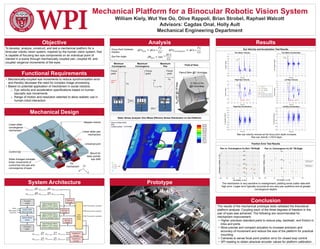MotorEyes MQP Poster_Onal1301 (1)
•Download as PPTX, PDF•
0 likes•46 views
The document describes the development of a mechanical platform for a binocular robotic vision system inspired by human vision. The platform uses mechanically coupled pan, tilt, and vergence movements to focus two eye components on points of interest, reducing the need for complex image processing. Testing validated the theoretical design analysis and achieved coupling of the three degrees of freedom. Recommendations include using more precise parts and actuation to increase precision and accuracy of eye movements.
Report
Share
Report
Share

Recommended
Recommended
More Related Content
Similar to MotorEyes MQP Poster_Onal1301 (1)
Similar to MotorEyes MQP Poster_Onal1301 (1) (20)
Fisheye/Omnidirectional View in Autonomous Driving V

Fisheye/Omnidirectional View in Autonomous Driving V
Computational visual system to reduce setup time in CNC vertical machining ce...

Computational visual system to reduce setup time in CNC vertical machining ce...
Self-Driving Car to Drive Autonomously using Image Processing and Deep Learning

Self-Driving Car to Drive Autonomously using Image Processing and Deep Learning
IRJET- In-Situ Monitoring for Fatigue Crack Detection using Control System an...

IRJET- In-Situ Monitoring for Fatigue Crack Detection using Control System an...
Development of Computer Vision based Windshield Wiper Control System for Auto...

Development of Computer Vision based Windshield Wiper Control System for Auto...
Fisheye based Perception for Autonomous Driving VI

Fisheye based Perception for Autonomous Driving VI
IRJET- Front View Identification of Vehicles by using Machine Learning Te...

IRJET- Front View Identification of Vehicles by using Machine Learning Te...
MotorEyes MQP Poster_Onal1301 (1)
- 1. Mechanical Platform for a Binocular Robotic Vision System Objective Functional Requirements Mechanical Design To develop, analyze, construct, and test a mechanical platform for a binocular robotic vision system, inspired by the human vision system, that is capable of focusing two eye components on an individual point of interest in a scene through mechanically coupled pan, coupled tilt, and coupled vergence movements of the eyes. • Mechanically-coupled eye movements to reduce synchronization error and thereby decrease the need for complex image processing • Based on potential application of mechanism in social robotics: o Eye velocity and acceleration specifications based on human saccadic eye movements o Range of motion and resolution selected to allow realistic use in human-robot interaction The results of the mechanical prototype tests validated the theoretical platform analysis. Coupling each of the three degrees of freedom in the pair of eyes was achieved. The following are recommended for mechanism improvement: • Higher precision standard parts to reduce play, backlash, and friction in links and joints • More precise and compact actuation to increase precision and accuracy of movement and reduce the size of the platform for practical mounting • Cameras to sense focal point position error for closed loop control • SPI reading to obtain absolute encoder values for platform calibration System Architecture Stepper motors Linear slider convergence mechanism Control bar Tilt mechanism Mount for laser-pointer eye (left) Universal joint x y z Slider linkages translate linear movements of control bar into pan and convergence of eyes Linear slider pan mechanism ΔCz ΔCx Analysis Focus point Focus point Focus point Minimum Convergence Maximum Convergence Maximum Pan +x +z Fz FxLines of sight ΔCz ΔCx Prototype Results Conclusion Pan=2.84m @1.5cm/step 0.75m-2.7m @2.0cm/step θTilt=90º@1.8º/step y -x z Field of View eyes Static Stress Analysis (Von Mises Effective Stress Distribution on the Platform) Eye Velocity and Acceleration Test Results Position Error Test Results The mechanism is very sensitive to misalignment, yielding some outlier data with high error. Larger error typically occurred at non-zero pan positions and at greater convergence depths. Max eye velocity reduces as the focus point depth increases Max eye velocity = 230.8 deg/s Fx = 0 Fx =104 cm Fx = -104 cm Fx = 0 Fz from 75 to 178 cm Fz from 178 to 273 cm Focus Point Cartesian Position: Eye Pan Angle: